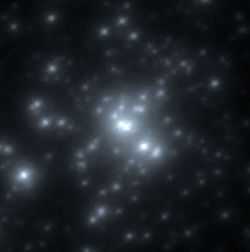R136a2
 The central region of the R136 star cluster as seen in near infrared. R136a2 is seen as the slight bump of light at the upper left surface of the much more luminous star R136a1 near the center. | |
| Observation data Epoch J2000 Equinox J2000 | |
|---|---|
| Constellation | Dorado |
| Right ascension | 05h 38m 42.45s[1] |
| Declination | −69° 06′ 02.2″[1] |
| Apparent magnitude (V) | 13.38[1] |
| Characteristics | |
| Evolutionary stage | Wolf-Rayet star[1] |
| Spectral type | WN5h[1] |
| Astrometry | |
| Distance | 165,000 ly |
| Absolute bolometric magnitude (Mbol) | -12.2[2] |
| Details | |
| Mass | 195[2] M☉ |
| Luminosity (bolometric) | 6,000,000[2] L☉ |
| Temperature | 50,000 K |
| Age | ≥ 2 Myr |
| Other designations | |
NGC 2070 MH 511, BAT99 109[1] | |
R136a2 (RMC 136a2) is a Wolf-Rayet star located near the center of the R136 super star cluster, which is located near the center of the Caldwell 103 complex, near the upper left corner of the neighboring galaxy Large Magellanic Cloud. It is one of the most massive stars known, at almost 200 solar masses. It is also one of the most luminous stars known at some six million times the luminosity of the Sun. It is located near R136a1, a more massive and more luminous star. Both are the most largest, most massive, and also the most luminous stars of R136, themselves producing most of the light that makes the entire C103 complex visible. The mass of the star was determined together with R136a1 by Paul Crowther et al in 2010.
Discovery
The star was discovered by a team of British astronomers led by Paul Crowther, a professor of astrophysics at the University of Sheffield, at the Very Large Telescope in the Atacama Desert in Chile, with additional data from the Hubble Space Telescope. The team were studying two star clusters, namely NGC 3603 and R136.[2][3] In their study, they spotted three stars in R136 with masses >150 solar masses, including R136a1 and R136a2, the other being R136c.
Properties
Like all Wolf-Rayet stars, R136a2 is undergoing a severe mass loss by shedding its mass in a continuous stellar wind. The high mass of the star pushes its core and ignites fusion at a higher rate, thereby it has an extremely high luminosity. The energy produced by this star is so great that the 12 second energy of this star is equal to that of the energy that the Sun produces in a year. Although still on the main sequence, it may be a 220 solar mass star at the time it was born and lost as much as 30 solar masses in the past 1 to 2 million years. However, since current theories suggest that no stars can be born above 150 solar masses, it may be a merger of two or more stars.
Fate
The future of R136a2 still depends on its mass loss. If the star is above 150 solar masses at the time of its death, it may explode as a pair-instability supernova, a very luminous stellar explosion caused by the runaway production of positron pairs, leaving no remnant behind, similar to the luminous supernovae SN 2006gy, SN 2005ap and SN 2006tf. It may be possible that the star may explode as a hypernova, or even a gamma-ray burst. If the star loses mass down to 130 solar masses, it may explode as an ordinary supernova, leaving either a neutron star or a black hole.
References
- ↑ 1.0 1.1 1.2 1.3 1.4 1.5 "SIMBAD Astronomical Database". Basic data for Cl* NGC 2070 MH 511.
- ↑ 2.0 2.1 2.2 2.3 Crowther, P. A.; Schnurr, O.; Hirschi, R.; Yusof, N.; Parker, R. J.; Goodwin, S. P.; Kassim, H. A. (2010). "The R136 star cluster hosts several stars whose individual masses greatly exceed the accepted 150 M⊙ stellar mass limit". Monthly Notices of the Royal Astronomical Society 408 (2): 731. arXiv:1007.3284. Bibcode:2010MNRAS.408..731C. doi:10.1111/j.1365-2966.2010.17167.x.
- ↑ "A 300 Solar Mass Star Uncovered". ESO Press Release. 2010-07-21.
| ||||||||||||||||||||||||||